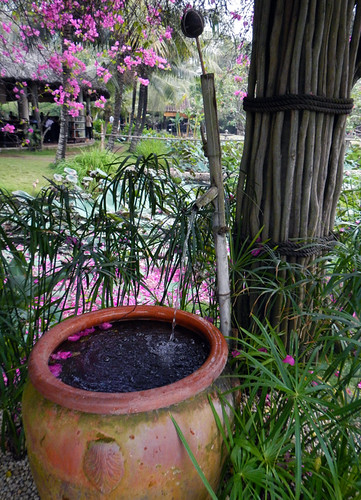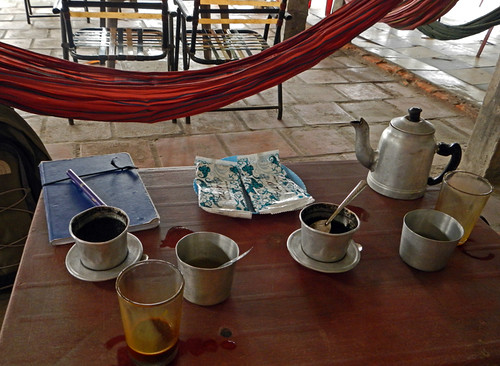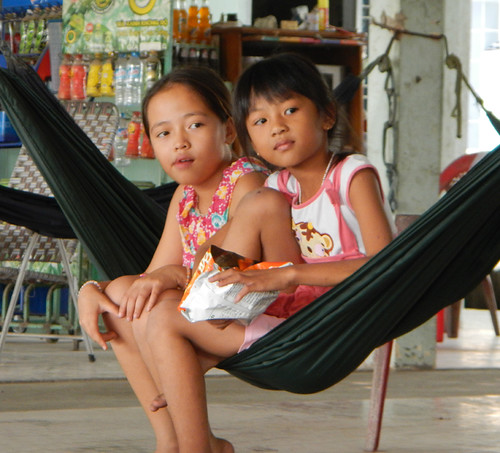On our way back to HCMC from the Mekong we would be stopping for lunch. “At one of the Hammock Cafés?” I asked excitedly.
I had been fascinated by the string of cafés along the highway between Saigon and the Mekong, where each el cheapo plastic table was combined with a hammock for lounging. So imagine my disappointment when we ended up at ‘The Tourist Trap’ .
The ‘Trap’ had everything most tourists like to believe about Vietnam: beautifully landscaped grounds, exquisitely arranged and tasty food (Vietnam doesn’t have bad food), immaculate washrooms and traditionally-dressed waitresses. But not very authentic. And very PRICEY!!!
So imagine my delight when our guide later asked if I would like to have a coffee break at one of the ‘Hammock Cafés’. Here I will try and show the difference between the two with three photos of each…
The ‘Trap’: beautifully landscaped.
 The ‘Hammock Café’: no landscaping, unless you consider a busy highway a landscape.
The ‘Hammock Café’: no landscaping, unless you consider a busy highway a landscape.
 The ‘Trap’: an exquisitely presented lunch of salad rolls with peanut sauce and passionfruit juice.
The ‘Trap’: an exquisitely presented lunch of salad rolls with peanut sauce and passionfruit juice.
 The ‘Hammock Café’: the best coffee in the world!
The ‘Hammock Café’: the best coffee in the world!
 This photo challenge is to tell a story with three carefully selected photos. At this point my attempt falls short. I didn’t take any photos of the waitresses at the ‘Trap’, but they were all wearing the Vietnamese áo dài, traditional gowns that nowadays seem to be worn only in Tourist Traps. At the ‘Hammock Café’ the wardrobe was just like everywhere else in Vietnam.
This photo challenge is to tell a story with three carefully selected photos. At this point my attempt falls short. I didn’t take any photos of the waitresses at the ‘Trap’, but they were all wearing the Vietnamese áo dài, traditional gowns that nowadays seem to be worn only in Tourist Traps. At the ‘Hammock Café’ the wardrobe was just like everywhere else in Vietnam.
 Other photos that I could have taken to tell this story could have been of the two very different washrooms. Or the two very different bills. If memory serves me rightly, the coffees at the Hammock Café were 60¢ each, whereas at the ‘Trap’ a cup of iced coffee was about $4 or $5.
Other photos that I could have taken to tell this story could have been of the two very different washrooms. Or the two very different bills. If memory serves me rightly, the coffees at the Hammock Café were 60¢ each, whereas at the ‘Trap’ a cup of iced coffee was about $4 or $5.
This was an interesting photo challenge, using three images to tell a story. Obviously I can’t go back to Vietnam and pick up my missing shots, but next time I will be thinking a little bit more about the ‘story’, and not just snapping pretty pictures.
For more on this challenge: Weekly Photo Challenge: Threes


I love the tin tea set that the hammock cafe used. There is a pie shop in Sydney that only uses tin plates and I just think it looks so nice and rustic!
Somehow I felt so much more ‘in Vietnam’ at the Hammock Café, with the tinware and everything. Plus there were dozens of these Cafés, and only a couple Tourist Cafés.
I enjoyed viewing your entry of photos, They all told a very true story of most tours taken on vacation. Ironic, how the eye likes to see only the beautiful when there can be a story in something simple.
Love the 2 girls on the hammock – natural.
I was lucky our guide was willing to break from the usual formula tour to give us a chance for a more authentic experience.
Great story – and I agree, the photo challenge reminds us that there may be more of the story to tell. Thank you so much for the follow, too – I appreciate it!
I fell in love with those hammock cafés the first time I travelled Viet Nam. The tourist trap place you visited looks lovely, even if it was so pricey. These days, in terms of decor and price, there isn’t much difference between the trap places and the upscale or midscale places that Vietnamese frequent, but the menu and the clientele tell you what you need to know.
You’re right that the áo dài is often worn by women in tourism and hospitality, but you’ll also see it on schoolgirls in some areas, central Vietnam for instance, as well as by older family members of brides and grooms at a wedding, at other important ceremonies, by traditional and spiritual music ensembles…and at all of these, you will see men wearing a version of áo dài too. What tourists don’t usually see is that áo dài styles are always changing. One year wide pant legs are in, with the fabric flooding over the shoes, and the next, the legs might be quite narrow. Sleeve lengths and necklines change too, as do the patterns and fabrics. The áo dài I wore to my wedding is now, alas, way out of style.
Your last photo is a winner. 🙂
I was in Vietnam twice for a month each time. In 1993 I saw a fair number of women wearing the ao dai and they are certainly very elegant and would be perfect for special occasions.
But in 2013/14 I only saw them in tourist traps. We were told that school girls still wore the ao dai, but in general women didn’t wear them any more because they were dangerous to wear on motorcycles, getting caught in the gears. Certainly the fashion statements I saw on my last trip were more about bright motorbike helmets and matching breathing masks!
Fashion has indeed changed a lot in VN in the last decade. But the áo dài is still there . . . just not quite as visible, and perhaps it depends where you are and how much time you spend sharing locals’ lives. My younger relatives in Central VN still cycle to school wearing theirs, and cycle home again after classes. The first thing they do when they get home is change into jeans, dresses, or comfy pajamas, depending on their plans. They also wear their áo dài to ceremonies, the pagoda at Tết, and special events at their schools, and learn how to tuck the long flaps to keep them from getting caught in bike chains or motorbike gears. But the tunic is certainly never worn simply to go out on the town–that’s a fact!